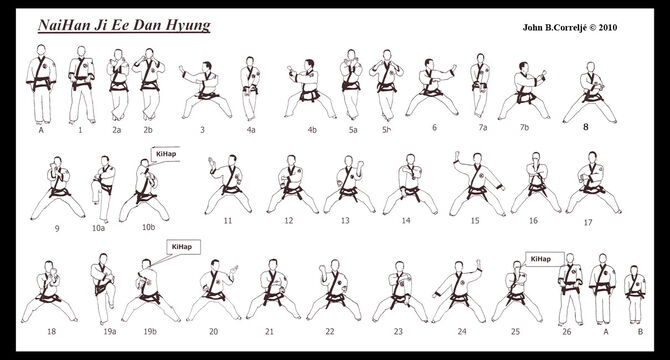This form is a traditional taekwondo form, meaning it pre-dates contemporary forms (such as those used by the ITF, ATA, and WT). In other words, this is a form used during the 1950s within the Nine Kwans that eventually came together to form taekwondo.
- Older forms such as this one were often based on forms from other martial arts.
- The details and names of these older forms tend to vary more widely from school to school as well.
The version shown here is just one version; the reader should recognize that there will be variations among schools.
Naihanchi (ナイハンチ?) (or Naifanchi (ナイファンチ?), Tekki (鉄騎?)) is a karate Kata, performed in horse-riding (straddle) stance (naihanchi-dachi (ナイハンチ立ち?) / kiba-dachi (騎馬立ち?)). Its name translates to internal divided conflict. The form makes use of close-in fighting techniques and grappling. There are three modern kata derived from this (Shodan, Nidan and Sandan).
Some researchers believe Nidan and Sandan were created by Anko Itosu, but others believe that it was originally one kata broken into three separate parts (probably due to constraints of space). The fact that only Naihanchi/Tekki Shodan has a formal opening suggests the kata was split. In Traditional Taekwondo the three forms in this series include:
- Naihanchi Cho-Dan (also called Chul-Gi)
- Naihanchi Ee-Dan
- Naihanchi Sam-Dan
It has been suggested the kata was originally developed when fighting against a wall / ledge / narrow confined space which is unlikely[citation needed]; however it could be used for this purpose. Whilst the kata is linear, moving side to side, the techniques can be applied against attackers at any angle. The side to side movements in a low stance build up the necessary balance and strength for fast footwork and body shifting. The kata are intricate strategies of attacking and defensive movement, done in the kiba dachi, for the purpose of conditioning the legs to develop explosive power. If one rotates one's torso a few degrees to one side or the other while performing Naihanchi/Tekki, the result is the Hachi-monji, or figure eight stance.
Video
Diagram
This diagram is copyright John B. Correljé and is used with permission. Terms and conditions are available at http://sites.google.com/site/tangsoodochonkyong 
Written Instructions
See: http://www.trinityshotokan.com/documents/tekki_nidan.html
